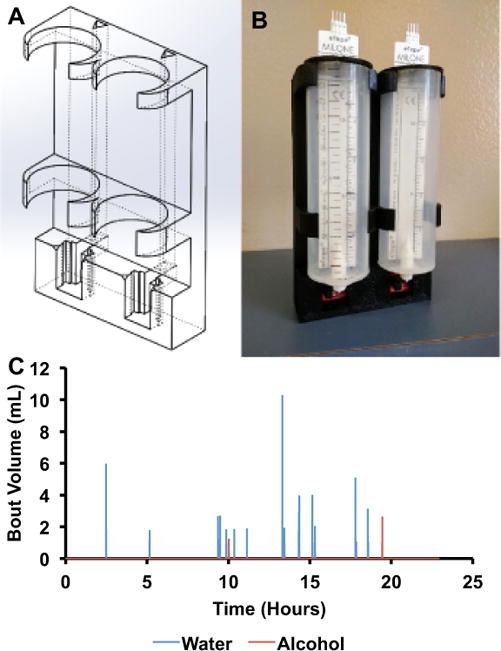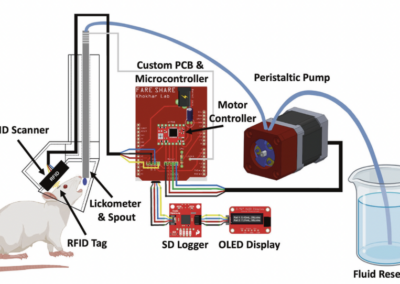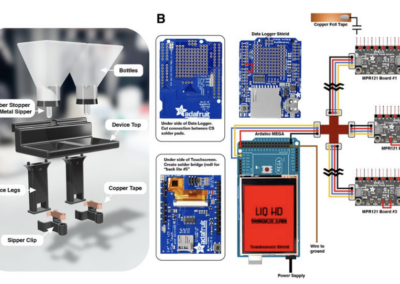Elizabeth Godynyuk and colleagues from the Creed Lab at Washington University, St. Louis recently published their design for a two-bottle choice homecage apparatus in eNeuro. It incorporates the original design (published on Hackaday.io in May 2018), modifications from Jude Frie and Jibran Khokar (Frie & Khokhar, 2019), and additional improvements over the course of use. This project is a great example of collaborative open-source tool development. Studies of liquid ingestive behaviors are used in neuroscience to investigate reward-related behavior, metabolism, and circadian biology. Accurate measurement of these behaviors are needed when studying drug administration, preference between two substances, and measuring caloric intake. To measure consummatory behavior in mice between two liquids, members of the Creed lab designed a low-cost and arduino-based device to automatically measure consumption in a homecage two-bottle choice test. Posted to Hackaday in May 2018, the initial version of the device used photointerrupters to measure time at the sipper, 15 mL conical tubes for volumetric measurements of fluid, and a 3D printed holder for the apparatus. Data from the photobeams are recorded to an SD card using a standard Arduino. In August 2018, the project was updated to Version 2, to make it battery powered and include a screen to display data. They made the editable TinkerCAD design available on hackaday.io. In October 2018, Dr. Jibran Khokhar and colleagues at the University of Guelph posted a project log highlighting the modifications making the device larger and suitable for studying liquid intake in rats. This updated design was published in April 2019 in HardwareX. This device gives the advantage of being able to analyze the drinking microstructure by recording licking behavior and volume consumed in real time. Modifications include larger liquid reservoirs and adding a hydrostatic depth sensor, allowing each bout of drinking to correspond to a specific change in volume. In current day, Elizabeth Godynyuk and colleagues from the Creed lab have shared their own updated version of the device in eNeuro. It remains low-cost and open-course and results validating the device with preference testing are shared. Furthermore, the authors show that the two-bottle choice test apparatus can be integrated with a fiber photometry system. In the eNeuro article, Godynuyuk et al. cite Frie and Khokhar’s modifications to highlight how the design can be easily adjusted to fit investigator needs. These two projects show how open source projects can be modified and how different groups can collaborate to improve upon designs. This shows how open source projects allow research groups can modify designs to best address their research questions instead of forming their research questions based on the commercial tools available. This research tool was created by your colleagues. Please acknowledge the Principal Investigator, cite the article in which the tool was described, and include an RRID in the Materials and Methods of your future publications. RRID:SCR_021445 Godynyuk et al 2019 (eNeuro): https://www.eneuro.org/content/6/5/ENEURO.0292-19.2019.long Creed Lab Version 2: https://hackaday.io/project/160388-automated-mouse-homecage-two-bottle-choice-test-v2
Automated Home-Cage Rodent Two-bottle Choice Test


Paper

Hackaday
Have questions? Send us an email!
Frie and Khokar 2019 (HardwareX): https://www.sciencedirect.com/science/article/pii/S2468067219300045#b0005
Creed Lab Version 1: https://hackaday.io/project/158279-automated-mouse-homecage-two-bottle-choice-test




